Shape and Connections
Contents
In Go, shape refers to the relations between stones. Beginners will often make bad shape, and as a result they risk their stones being killed. This lesson will show some differences between good and bad shape.
This lesson also explains different ways which you can connect your stones. It is important to understand how to keep your stones connected in the most efficient way possible.
Good shape
Return to Top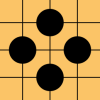
Dia. 1: This strong shape is called a ponnuki.
A great example of good shape is the diamond (dia. 1). It is usually formed after capturing a single stone, in which case it is called a ponnuki. A ponnuki has influence in all directions, and can not be cut apart. There is a common proverb which says, "a ponnuki is worth thirty points." Players will rarely spend four moves to make a ponnuki, but the proverb tells us that if one occurs, it is very valuable.
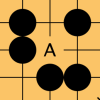
Dia. 2: The mouth shape, similar to the net.
You may have already seen the mouth shape (dia. 2) in the form of the net. It is strong (especially in the center of the board) because it can not be separated, and forms an eye at A. It can also extend in many directions, depending on the opponent's stones.
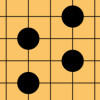
Dia. 3: A variant of the mouth shape.
This variant of the mouth shape is sometimes better because it uses less stones (dia. 3). In the diagram, Black's stones are still connected because White would need at least two moves to disconnect them.

Dia. 4: The bamboo joint. Notice how the stones are connected.
The bamboo joint (dia. 4) is also a strong shape. It is a very good way to connect your stones. In the diagram, the Black stones cannot be separated and Black does not need to respond to the White peeps at A or B.
Bad Shape
Return to Top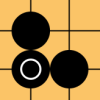
Dia. 5: The emptry tiangle shape is usually bad because the marked stone is unnecessary.
A classic example of bad shape - and one that all beginners should learn quickly - is the emptry triangle (dia. 5). It is considered bad because the stone marked with a circle is not necessary to connect the other two stones. It is a wasted stone which could have been used elsewhere. Also, this shape has less liberties than other shapes with three stones. If you ever find yourself about to play an empty triangle, ask yourself if you can play a better move.
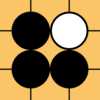
Dia. 6: The full triangle is different from the empty triangle.
Keep in mind that when an opponent's stone is present, the shape is called a full triangle (dia. 6). This is not bad shape - Black's stones are working efficiently to attack the White stone (which only has two liberties). It is important to know the difference between an empty triangle and a full triangle.
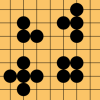
Dia. 7: More examples of bad shape. Note that some stones are not necessary.
It is important to be mindful of your stones and avoid making bad shape. Diagram 7 shows more examples. Notice how each Black group is inefficient. Moves have been wasted when connecting the stones. These shapes have fewer liberties than others with the same number of stones, and are easier to capture.
Connections
Return to Top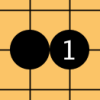
Dia. 8: Stretching
In Go, there are many ways to keep your stones connected. The most basic is simply stretching - playing a stone adjacent to another one (dia. 8). This move is strong and defensive (the stones cannot be separated), but it is also very slow.
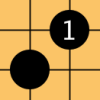
Dia. 9: The diagonal.
Similar to stretching, the diagonal (dia. 9) is another strong but slow move. The two stones can always be connected, on one side or the other (but don't connect unnecessarily and create an empty triangle!).
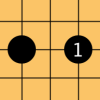
Dia. 10: The one-point jump.
The one-point jump (dia. 10) is slightly faster that the previous two connections, and it is still very strong. However, there may be some vulnerabilities depending on nearby stones.
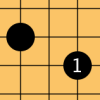
Dia. 11: The small knight's move.
The knight's move (dia. 11) gets its name from chess, where the knight piece moves with a similar "L" shaped pattern. The knight's move is useful when attacking. However, it is not as strong or defensive as the one point jump because it can be cut apart.
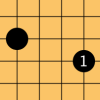
Dia. 12: The large knight's move.
The large knight's move (dia. 12) extends one space further than the knight's move. This is a very fast move, but it is only barely connected. It is often used when trying to surround a large area along the side or corner of the board.
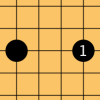
Dia. 13: The two-point jump.
The two-point jump (dia. 13) is also fast, but very loosely connected. There are many ways to cut it apart, especially when there are no supporting stones nearby. However, it is used often as a side extension because of its lightness and speed.
Conclusion
Return to TopIt is very important to understand the differences between good and bad shape. Without good knowledge of shape and connections you may find your stones separated and under attack. Always try to make your stones work well with each other in the most efficient way possible.
For further review, some study problems based on shape and connections are available.
Suggested Reading
Return to Top- Making good shape (Mastering the basics, vol. 3) by Rob Van Zeist